2.6 הכנה לְשׂיחה - Working in a Hebrew environment -
One of the quickest and easiest ways to learn Hebrew is
to make sure that the activities that form part of your regular routine
are conducted in Hebrew. You will find that if you make a habit of
referring to those activities
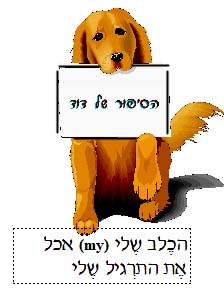 by their Hebrew names (עבודה
בְקְבוּצות for example) and you make the effort to use the Hebrew
phrases for each type of regular request or communication ("My dog ate
my term paper", "Is there a make-up exam?") you will soon have a
sizeable Hebrew repertoire.
by their Hebrew names (עבודה
בְקְבוּצות for example) and you make the effort to use the Hebrew
phrases for each type of regular request or communication ("My dog ate
my term paper", "Is there a make-up exam?") you will soon have a
sizeable Hebrew repertoire.
Let's review our dialog for getting acquainted:
שלום, מי אתה
שְמי יונתן
נעים מְאוד
שְמי
Now we will expand on the "getting acquainted" conversation. The next time they meet:
נעמה: שלום יואב Hello, Yoav
יואב: בוקר טוב נעמה Good morning, Naamah
נעמה: מה שלומְךָ How are you?
יואב: טוב, תודה. מה שלומֵךְ?
Good, thank you, How are you?נעמה: מצוּיין! מה חדש?
Excellent! What's newיואב: אני לומֵד עברית.
I'm learning Hebrewנעמה: אֵיפֹה ?Where
יואב: באוּניברסיטה .At the university
נעמה: טוב, שלום וּלְהִתְראות OK, Good-bye, see you later
The following page has a list of some phrases that are likely to recur frequently. You may wish to keep a notebook for other phrases that are used often.
Title it: "Things I have always wanted to say in Hebrew".
"how do you say in Hebrew . . .? - ?"אֵיך אומְרים בְּעִבְרית
83
100.00 %
2.6.1 ביטוּיים Common Classroom Expressions

again עוד פּעם
please repeat after me בְבקשה לחזור אחריי
slower please יותֵר לְאט בּבקשה
correct נכון
incorrect לֹא נכון
come to the chalkboard
בואי אֶל הלוּחַ
בוא אֶל הלוּחַ
sit
שְבי
שֵב
let me see
תְני לי לִרְאות
תֵן לי לִרְאות
put
שימי
שים
go
לְכי
לֵךְ
who knows
מי יודעת ?
מי יודֵעַ ?
who wants
מי רוצה?
מי רוצֶה ?
I don't know
אני לֹא יודעת
אני לֹא יודֵע
I don't understand
אני לא מְבינה
אני לא מֵבין

![]()
please write
בְבקשה לִכְתוב
please write in the notebook
בְבקשה לִכְתוב במחְבֶּרֵת
please read
ְבבקשה לִקְרוא
very good
טוב
good
טוב מְאוד
excellent
מְצוּיין
I forgot
שכחְתי
thanks
תודה
pardon me
סְליחה
class session
שיעוּר
homework
שיעוּרֵי בית
to mark
לְסמֵן
how do you say?
אֵיךְ אומְרים
84
2.6.2 בּיטוּיים - עבודה בקְבוּצות
Look at the pictures below. Choose A classroom expression from ¶2.6.1 that you think fits a picture and write it in on the line below the picture. Do this for each of the pictures.

______________ 3 ______________2 ______________1

______________ 6 ______________5 ______________4

______________ 9 ______________8 ______________7
85
2.7 על הניקוּד About Vowel Marks
In the Hebrew prayer book, Hebrew Bible, poetry or songs the spelling is different from that used in everyday writing. In everyday Hebrew the vowel marks are not used.
The letters vahv ו and yood י are added in texts without nikkud to make them easier to read. The ו is used instead of the vowel mark ֻ We will write וּ for that sound .
The letter ו is also used to replace the small /oh/ dot you find to the left of a letter (for example when reading in the prayer book). So בּוקֶר = בּׂקֶר
Sometimes you will see two letters /vav/ together וו to tell you that here the /vav/ is pronounced with the sound /v/ and is not a vowel.
The letter י is used in everyday Hebrew after a consonant to show that the consonant should be read with the sound /ee/ and sometimes /eh/ for example /ki-tah/ כּיתה (rather than כּתה) .
Spelling that uses these "extra" vahv or yood letters for vowels is called כְּתיב מלֵא and spelling without the vahv or yood is referred to as כְּתיב חסֵר
As you read the list of words below, you have two tasks:
1. Notice the different spellings of the same words The first column shows how the word would be spelled in a prayerbook or any text that uses כְּתיב חסֵר .
2. The second column shows the way you would see it in a newspaper or other books. And it is the way that you would write Hebrew yourself. Look at the difference in the way each word is written.
As you can easily imagine, writing without using the י and ו as vowel letters makes words more difficult, and the reading of a text without nikkud requires knowledge of grammar and a lot of reading experience.. And since Modern Hebrew is written without the ניקוּד... You will be happy that we use כְּתיב מלֵא in this book.
100.00 %
כְּתיב מלֵא
כְּתיב
חסֵר
כְּתיב מלֵא
כְּתיב
חסֵר
אנְגְלית
אַנְגְלִית
בּוקֶר
בּׂקֶר
יפה
יָפָה
בְּיחד
בְּיַחַד
עכְשיו
עַכְשָו
עגול
עָגֹל
כֵּן
כֵּן
לְאט
לְאַט
אישה
אִשָה
מִיכְתב
מִכְתָב
לִקְרוא
לִקְרֹא
לִשְתוק
לִשְתֹק
עבְרית
עִבְרִית
אוּלי
אוּלַי
כּיתה
כִּתָּה
מְאוד
מְאֹד עגוּלה עֲגֻלָה מְצוּיין מְצֻיָן כּוּלם כֻּלָם דיבֵּר דִבֵּר 86
2.7.1
שְמות
הניקוּד
Vowel Marks
Learn the names of vowels
we use most frequently in our text. Practice writing the
name of each vowel on a blank piece of paper while you also
say it out loud.
צֵירֶי
=
ֵ
________
סֶגול=
ֶ
________
חִירִיק=
ִ
________
שְווא=
ְ _______
דגֵש =
בּ כּ
פּ
The
dot in the letter
2.8
שִמְעון אומֵר
GAME: "SIMON SAYS
שִמְעון אומֵר Responding physically to spoken commands is an
excellent way to acquire vocabulary quickly. So put aside any
inhibitions...Stand up and play "שמעון
אומֵר"
100.00 %
שמעון אומֵר: ידיים על ה_______________________
behind
1.
רֹאש
knees
9.בִּירְכַּיים
2.
אף
teeth
10.שיניים
3.
פֶּה
11.
לקוּם
4.
צוָואר
12.
לשֶבֶת
5.
עֵיניים
13.
לדבֵּר
6.
אוזְניים
14.
לִשְתוק
7.
בֶּטֶן
2.8.1
עבודה בִקְבוּצות
Group Work
As one student plays the role of "Simon," saying
the name of a part of the body out
loud, YOU
put your hands on part of the body
"Simon" named..
87
2.9
לִסְפּור מֵאחת עד עֶשֶֹר
COUNTING FROM ONE TO TEN
While you're still in "game mode".... Israeli children sometimes use this nursery rhyme for
skipping with a jump rope. It should help us learn to count from one to
ten. These are the feminine form of the numbers. This is the form used for
counting.
100.00 %
אחת, שְתיים --- יְרוּשלים
שלוש, ארְבּע --- אמריקה
חמֵש, שֵש
--- אתה טיפֵּש ! שֶבע, שמונֶה --- תַחְכְּמוני תֵשע, עֶשֶׂר --- אני פְּרופֶסור !
100.00 %
2.9.1
מָתֶמָטִיקָה,
בְּעבְרית How Much?
?כמה דוגמה:
שְתיים וְעוד שְתיים שווֶה ארְבּע
- 2 + 2 = 4 3 + 5 = 8 3 + 3 = 6 1 + 9 = 10
2 + 7 = _____________ 2 + 5 =_____________
4 + 2 = _____________ 5- 3 = 2
חמֵש פחות שלוש שוֶוה שְתיים 5 - 5 = 0
חמֵש פחות חמֵש שוֶוה אֶפֶס * For more on numbers see ¶2.20, ¶3.12 and the appendix. 88
![]() Use with
the Software, Chapter 2:6 "Simon Says"
Use with
the Software, Chapter 2:6 "Simon Says"
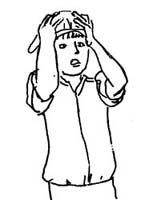
8.
ישְבן
head
nose
mouth
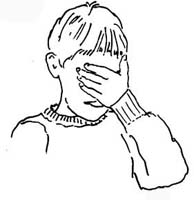
to stand up
neck
to sit down
eyes
to speak
ears
to be silent
stomach
![]() Use with the Software Chapter 2:7 "The Numbers One to Ten"
Use with the Software Chapter 2:7 "The Numbers One to Ten"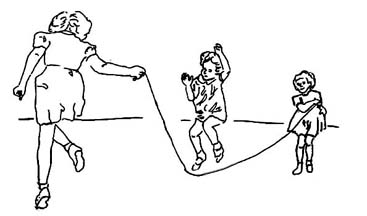
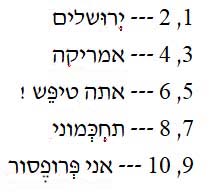
הֶעָרָה
What does this phrase mean?
See if you can use the information on the next page to figure out this Hebrew sentence.